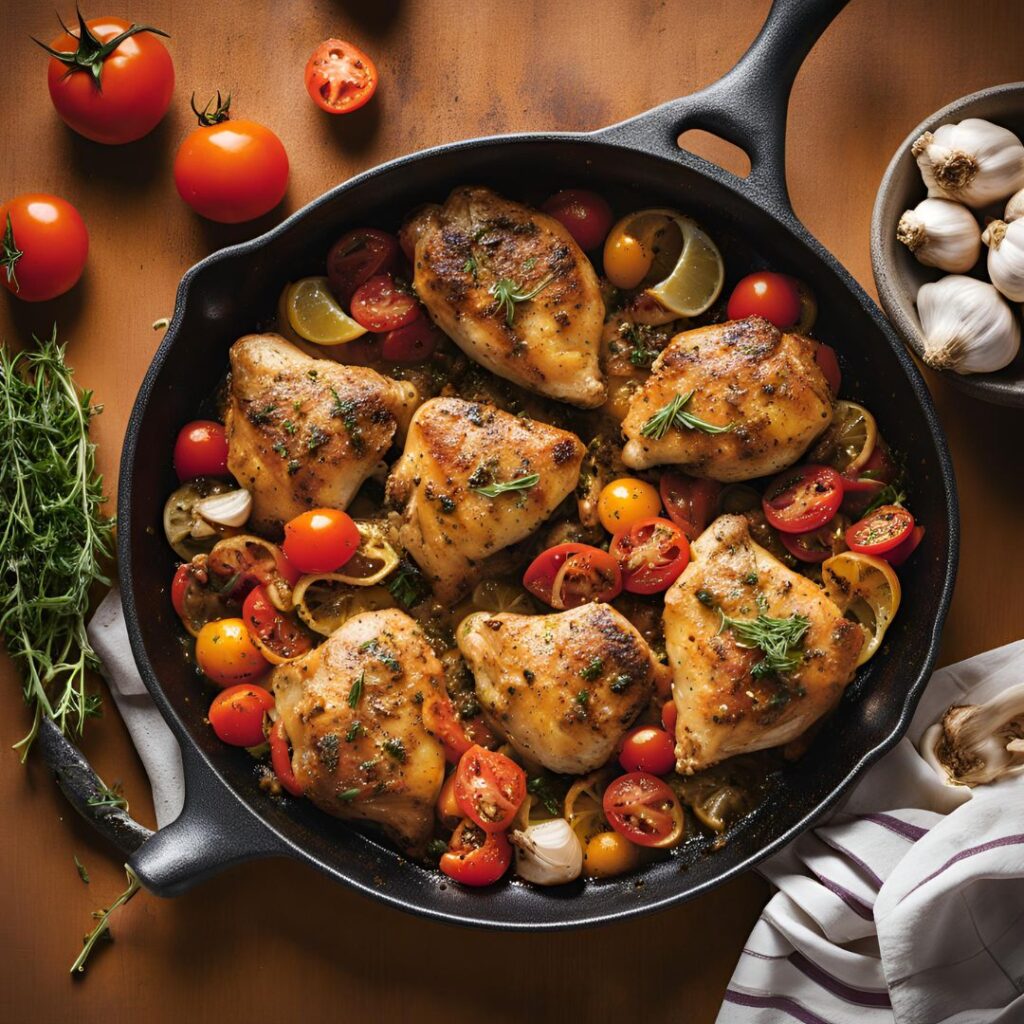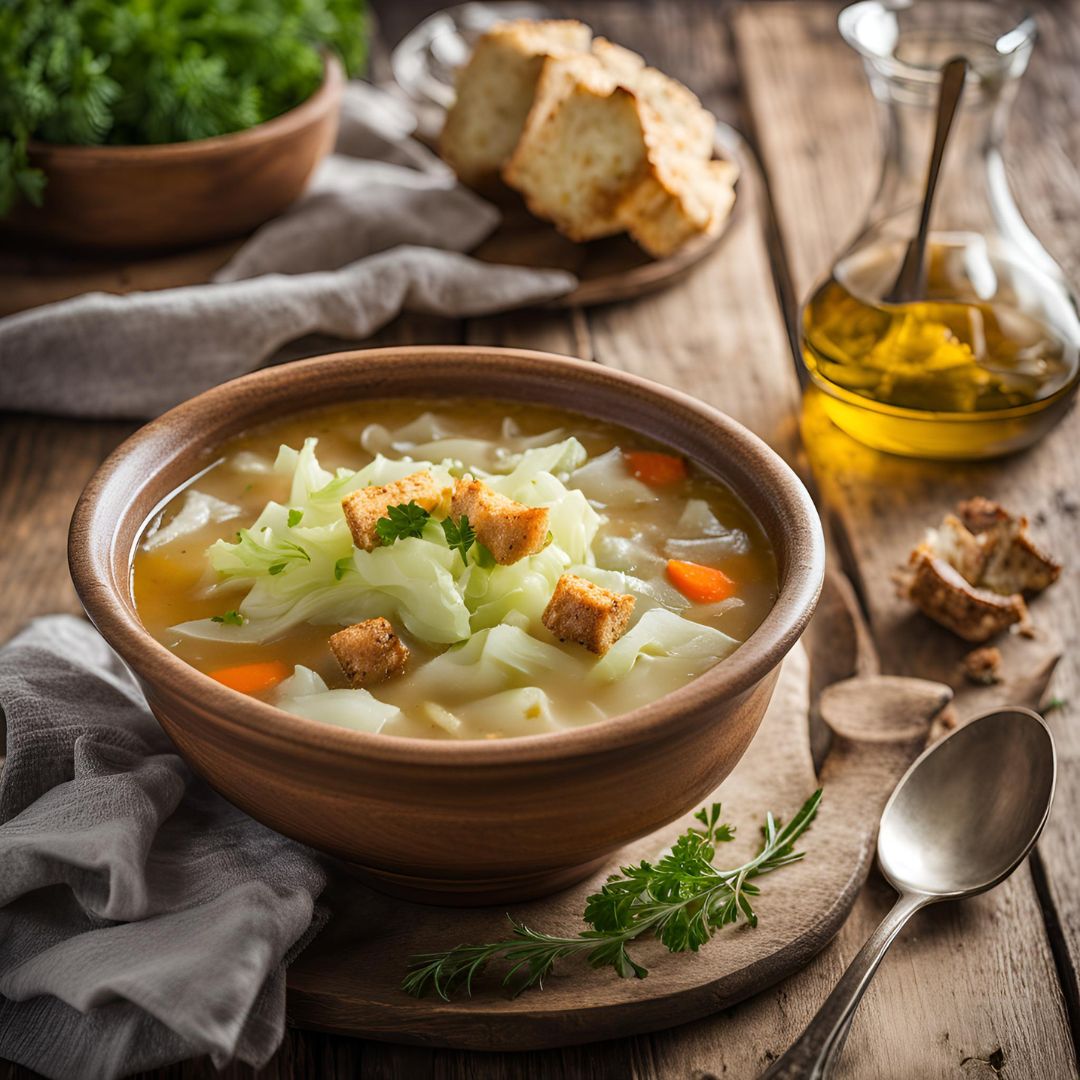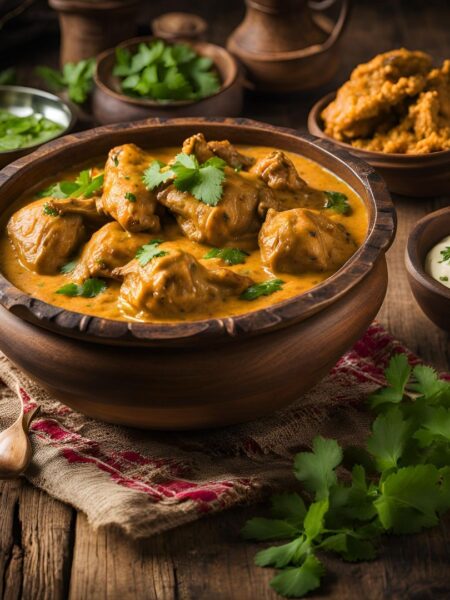Chicken Provençal Recipe: A Taste of Southern France in Your Kitchen. The culinary traditions of Provence, a region in the south of France, are world-renowned for their bold flavors, use of fresh ingredients, and rich history. With a cuisine that reflects its Mediterranean location, Provençal dishes emphasize the abundant use of olives, garlic, tomatoes, herbs, and olive oil. One dish that perfectly captures this regional essence is Chicken Provençal—a flavorful, aromatic, and deeply comforting meal that effortlessly brings the flavors of the French countryside to your dining table.
Chicken Provençal is much more than just a simple chicken recipe. It is a dish rooted in the history and culture of Provence, a reflection of the region’s dedication to natural, wholesome ingredients. Combining succulent chicken with an array of vibrant vegetables, olives, capers, garlic, and herbs, this dish balances richness with lightness, and complexity with simplicity. Whether you are a novice in the kitchen or a seasoned home cook, Chicken Provençal is an easy yet impressive recipe that promises to transport your taste buds to the heart of Provence.
But what exactly is it that makes Chicken Provençal so special? And how can you recreate this dish at home? In this article, we will dive into the origins of Chicken Provençal, explore its key ingredients, and provide a step-by-step guide to making it. By the end, you’ll not only have a new recipe to try, but a deeper appreciation for the culinary traditions of Provence.
The Origins of Chicken Provençal
To truly appreciate Chicken Provençal, it helps to understand the culture that created it. Provence is a region located in the southeastern part of France, bordering Italy and the Mediterranean Sea. With its warm climate and fertile soil, Provence is known for its bountiful produce, olive groves, and vineyards. Its cuisine is a celebration of these natural ingredients, with dishes often reflecting the simplicity and beauty of the land itself.
Chicken Provençal is a product of this rich agricultural tradition. The dish is a classic example of cuisine du soleil—a term often used to describe the “cuisine of the sun” from the Mediterranean regions. Sun-ripened tomatoes, briny olives, and aromatic herbs like thyme, rosemary, and oregano are at the core of Provençal cooking. These ingredients are abundant in the region and are the foundation of Chicken Provençal’s bold yet balanced flavors.
In Provence, cooking is more than just a means of sustenance; it is a way of life that emphasizes fresh, local ingredients. The use of olive oil, rather than butter or cream, is central to Provençal cooking, making it lighter and healthier than some other French regional cuisines. It’s also a cuisine where garlic reigns supreme, often referred to as the “truffle of Provence.” Chicken Provençal incorporates all these key elements, giving it a signature taste that is unmistakably Provençal.
Key Ingredients of Chicken Provençal
At the heart of Chicken Provençal are ingredients that you might already have in your pantry, but when brought together, they create something truly magical. Let’s break down the essential components that give this dish its distinctive flavor.
1. Chicken
While Chicken Provençal can be made with any cut of chicken, bone-in, skin-on chicken thighs or breasts are often preferred. The bones and skin add flavor to the dish as it cooks, and the slow simmering process helps keep the chicken juicy and tender. Thighs, in particular, are ideal because they are less likely to dry out compared to white meat, though both work wonderfully.
2. Olives and Capers
A hallmark of Provençal cooking is the generous use of olives, particularly briny Kalamata or green olives. They add a burst of saltiness and a slightly bitter edge that contrasts beautifully with the sweetness of the tomatoes. Capers, another Mediterranean favorite, bring a tangy, almost lemony bite that helps cut through the richness of the chicken.
3. Tomatoes
Tomatoes, whether fresh or canned, provide a bright, acidic base for the dish. In Provence, sun-ripened tomatoes are a summer staple, and their sweetness balances the savory flavors of the olives and capers. The tomatoes also help create a luscious sauce that envelops the chicken as it cooks, becoming richer and more flavorful the longer it simmers.
4. Herbes de Provence
No dish that claims to be Provençal would be complete without herbes de Provence. This aromatic blend of dried herbs—typically including thyme, rosemary, oregano, and sometimes lavender—captures the essence of the French countryside. These herbs add a fragrant complexity to the dish, making it taste like something straight from a rustic kitchen in the south of France.
5. Garlic
As mentioned earlier, garlic is a cornerstone of Provençal cooking. In Chicken Provençal, it is used generously, infusing the dish with its unmistakable pungency and depth. When sautéed alongside the onions and vegetables, garlic adds a rich, savory base that forms the foundation of the dish’s flavor profile.
6. White Wine
Wine is a staple in French cooking, and dry white wine is often used in Chicken Provençal to deglaze the pan and add a subtle layer of acidity. As the wine reduces, it intensifies the flavors of the sauce, melding with the tomatoes and herbs to create a rich, flavorful broth that coats the chicken.
Cooking Chicken Provençal
The beauty of Chicken Provençal lies in its simplicity. Despite the complex, layered flavors, this dish is remarkably easy to prepare. The key to success is in the timing and the balance of ingredients, which come together to create a deeply flavorful sauce that transforms the chicken into something special.
After seasoning the chicken with salt and pepper, the process begins by browning the chicken in olive oil until the skin is golden and crisp. This step is crucial as it creates a rich base flavor. Once browned, the chicken is set aside while the onions, garlic, and peppers are sautéed until soft and fragrant. Next come the tomatoes, olives, capers, and herbs, which are combined with white wine to create a fragrant, savory sauce.
The chicken is then returned to the pan and simmered gently in the sauce. As it cooks, the chicken absorbs the flavors of the herbs, wine, and olives, while the sauce reduces and thickens. In about 25 minutes, you’ll have a dish that tastes like it took hours to prepare.
A Versatile Dish for Every Occasion
One of the best things about Chicken Provençal is its versatility. It can be served with a variety of side dishes—crusty French bread, roasted potatoes, or even a simple green salad. The sauce is so rich and flavorful that it pairs beautifully with nearly any starch, soaking into rice or pasta with ease.
This dish is perfect for weeknight dinners because it’s relatively quick to make but also elegant enough for entertaining. The vibrant colors of the peppers, olives, and tomatoes make it visually stunning, while the rich flavors are sure to impress guests.
—
In Chicken Provençal, we see the best of what Provence has to offer: bold flavors, fresh ingredients, and a deep connection to the land. It’s a dish that celebrates the region’s culinary heritage while being approachable and easy to prepare. Whether you’re looking for a comforting meal for your family or an impressive dish for a dinner party, Chicken Provençal delivers on all fronts. With just a few simple ingredients, you can bring the taste of southern France into your home and enjoy a true Provençal experience.
Ingredients: Chicken Provençal Recipe
- 4-5 chicken thighs or chicken breasts
- 2 tablespoons olive oil
- 1 large onion, thinly sliced
- 4 cloves garlic, minced
- 1 red bell pepper, thinly sliced
- 1 yellow bell pepper, thinly sliced
- 1 can (14.5 oz) diced tomatoes (or 4 ripe tomatoes, chopped)
- 1/2 cup dry white wine
- 1/2 cup chicken broth
- 1/3 cup pitted Kalamata or green olives
- 1 tablespoon capers
- 1 teaspoon herbes de Provence (or a mix of dried rosemary, thyme, oregano)
- Fresh thyme sprigs (optional for garnish)
- Salt and pepper to taste
Cooking Instructions: Chicken Provençal Recipe
1. Prep the Chicken:
- Season the chicken with salt and pepper on both sides.
- Heat 2 tablespoons of olive oil in a large skillet over medium-high heat. When the oil is hot, add the chicken thighs, skin-side down. Cook for 6-8 minutes until the skin is golden brown and crispy.
- Flip the chicken and cook the other side for 4-5 minutes. Remove the chicken from the skillet and set it aside on a plate.
2. Cook the Vegetables:
- In the same skillet, add the sliced onion and garlic. Sauté for about 3-4 minutes, until softened and fragrant.
- Add the sliced bell peppers and cook for another 5 minutes until they soften.
3. Add Tomatoes, Wine, and Herbs:
- Stir in the diced tomatoes, white wine, chicken broth, olives, capers, and herbes de Provence.
- Bring the mixture to a simmer and cook for 5 minutes, allowing the flavors to meld together.
4. Combine with Chicken:
- Return the browned chicken to the skillet, nestling them into the tomato and pepper mixture.
- Lower the heat to medium-low, cover the skillet, and simmer for 20-25 minutes until the chicken is cooked through (internal temperature of 165°F or 75°C).
5. Serve:
- Taste the sauce and adjust the seasoning with salt and pepper if needed.
- Garnish with fresh thyme sprigs if desired, and serve hot.
Total Time Breakdown: Chicken Provençal Recipe
- Prep Time: 15 minutes
- Cook Time: 40 minutes
- Total Time: 55 minutes
- Number of Servings: This recipe serves 4.
Essential Cooking Tips For Chicken Provençal Recipe
1. Use Bone-In, Skin-On Chicken for Maximum Flavor
While you can make Chicken Provençal with any cut of chicken, using bone-in, skin-on thighs or breasts will enhance the flavor. The bones release flavor as the chicken simmers, and the skin, when seared properly, adds a delicious crispiness. It also locks in moisture, keeping the chicken tender throughout the cooking process. For best results, sear the chicken skin-side down until golden brown before simmering in the sauce.
2. Don’t Skip Browning the Chicken
Browning the chicken in olive oil before simmering it with the vegetables and sauce is a crucial step. This creates a deeper, more complex flavor base for the dish, as the caramelized bits (fond) left in the pan are deglazed by the wine and tomatoes, enriching the sauce. Make sure the pan is hot enough so the skin gets crispy without sticking to the pan.
3. Balance the Acidity with Sweetness
The tomatoes and white wine in Chicken Provençal provide a natural acidity, which is essential to the dish’s bright flavor. However, balancing this acidity is key to preventing the dish from becoming too sharp. If the sauce tastes too acidic, consider adding a pinch of sugar or a drizzle of honey to round out the flavors. Additionally, roasting your own fresh tomatoes or using ripe, in-season tomatoes can add natural sweetness.
4. Layer in the Herbes de Provence Gradually
Herbes de Provence is the aromatic blend of herbs that gives Chicken Provençal its signature flavor. Add the dried herbs early in the cooking process so they have time to infuse into the sauce, but for fresh herbs like thyme or parsley, wait until the end of cooking to stir them in. This way, they retain their bright, fresh flavor and don’t overpower the dish.
5. Simmer Slowly for Best Results
Once the chicken is seared and the sauce is assembled, lower the heat and let the chicken simmer gently in the sauce. Slow simmering ensures that the chicken stays tender and absorbs the flavors from the olives, capers, garlic, and tomatoes. Cooking the dish over medium-low heat for 20-25 minutes allows the sauce to reduce and thicken, creating a rich, flavorful base that clings to the chicken. Avoid boiling, which can cause the chicken to dry out and the sauce to reduce too quickly.
Some More Interesting Recipes –
- Vineyard Chicken Recipe
- Chicken Marengo Recipe
- Chicken Dijon Recipe
- Honey Mustard Curry Chicken Recipe
- French Onion Chicken Recipe
- Marry Me Chicken Recipe
Frequently Asked Questions (FAQs) – Chicken Provençal Recipe
1. Can I use boneless chicken for this recipe of Chicken Provençal?
Yes, you can use boneless, skinless chicken breasts or thighs, but bone-in, skin-on chicken adds more flavor and moisture to this Chicken Provençal Recipe. If using boneless chicken, reduce the cooking time to prevent it from drying out.
2. What is Herbes de Provence, and can I substitute it?
Herbes de Provence is a dried herb mix commonly used in French cooking, typically including thyme, rosemary, oregano, marjoram, and sometimes lavender. If you don’t have it, you can substitute with a combination of thyme, rosemary, and oregano.
3. Can I make Chicken Provençal ahead of time with this recipe?
Yes, Chicken Provençal can be made ahead of time with this recipe. In fact, the flavors often deepen as the dish sits. Simply reheat gently over low heat before serving. You may need to add a splash of water or broth to loosen the sauce if it thickens overnight.
4. What type of olives should I use for this recipe of Chicken Provençal Recipe?
Kalamata olives or green olives are typically used in Chicken Provençal recipe. Their briny, slightly salty flavor contrasts well with the sweetness of the tomatoes. You can use pitted olives to make eating easier or leave them whole for presentation.
5. What should I serve with Chicken Provençal made with this recipe?
Chicken Provençal with this recipe pairs well with a variety of sides such as crusty French bread, mashed potatoes, rice, couscous, or pasta to soak up the flavorful sauce. You can also serve it with roasted vegetables or a simple green salad.
6. Can I use red wine instead of white wine for this recipe of Chicken Provençal ?
White wine is traditional in Chicken Provençal recipe, adding a light acidity to the dish. However, you can use red wine if you prefer a deeper, richer flavor. Keep in mind that it will change the overall taste and color of the dish.
7. Is it necessary to use capers in Chicken Provençal Recipe?
Capers add a tangy, briny flavor that complements the olives and balances the richness of the chicken in Chicken Provençal Recipe. While not essential, they enhance the overall taste of the dish. If you don’t like capers or don’t have them on hand, you can leave them out.
8. Can I make this recipe of Chicken Provençal in a slow cooker?
Yes, you can make Chicken Provençal in a slow cooker. Sear the chicken first for better flavor, then transfer it to the slow cooker along with the other ingredients. Cook on low for 6-7 hours or on high for 3-4 hours.
9. How do I store leftovers, and how long will they last?
Store leftovers in an airtight container in the refrigerator for up to 3-4 days. You can also freeze Chicken Provençal for up to 3 months. To reheat, thaw overnight in the fridge and warm gently on the stovetop or in the microwave.
10. Can I add other vegetables to this recipe of Chicken Provençal?
Yes, Chicken Provençal recipe is versatile, and you can add other vegetables like zucchini, eggplant, or mushrooms. Just make sure to sauté them first or add them during the cooking process so they cook evenly with the chicken.
Chicken Provençal recipe
In Chicken Provençal, we see the best of what Provence has to offer: bold flavors, fresh ingredients, and a deep connection to the land. It’s a dish that celebrates the region’s culinary heritage while being approachable and easy to prepare. Whether you’re looking for a comforting meal for your family or an impressive dish for a dinner party, Chicken Provençal delivers on all fronts. With just a few simple ingredients, you can bring the taste of southern France into your home and enjoy a true Provençal experience.

Ingredients: Chicken Provençal Recipe
Cooking Instructions: Chicken Provençal Recipe
1. Prep the Chicken:
- • Season the chicken with salt and pepper on both sides.
- • Heat 2 tablespoons of olive oil in a large skillet over medium-high heat. When the oil is hot, add the chicken thighs, skin-side down. Cook for 6-8 minutes until the skin is golden brown and crispy.
- • Flip the chicken and cook the other side for 4-5 minutes. Remove the chicken from the skillet and set it aside on a plate.
2. Cook the Vegetables:
- • In the same skillet, add the sliced onion and garlic. Sauté for about 3-4 minutes, until softened and fragrant.
- • Add the sliced bell peppers and cook for another 5 minutes until they soften.
3. Add Tomatoes, Wine, and Herbs:
- • Stir in the diced tomatoes, white wine, chicken broth, olives, capers, and herbes de Provence.
- • Bring the mixture to a simmer and cook for 5 minutes, allowing the flavors to meld together.
4. Combine with Chicken:
- • Return the browned chicken to the skillet, nestling them into the tomato and pepper mixture.
- • Lower the heat to medium-low, cover the skillet, and simmer for 20-25 minutes until the chicken is cooked through (internal temperature of 165°F or 75°C).
5. Serve:
- • Taste the sauce and adjust the seasoning with salt and pepper if needed.
- • Garnish with fresh thyme sprigs if desired, and serve hot.





